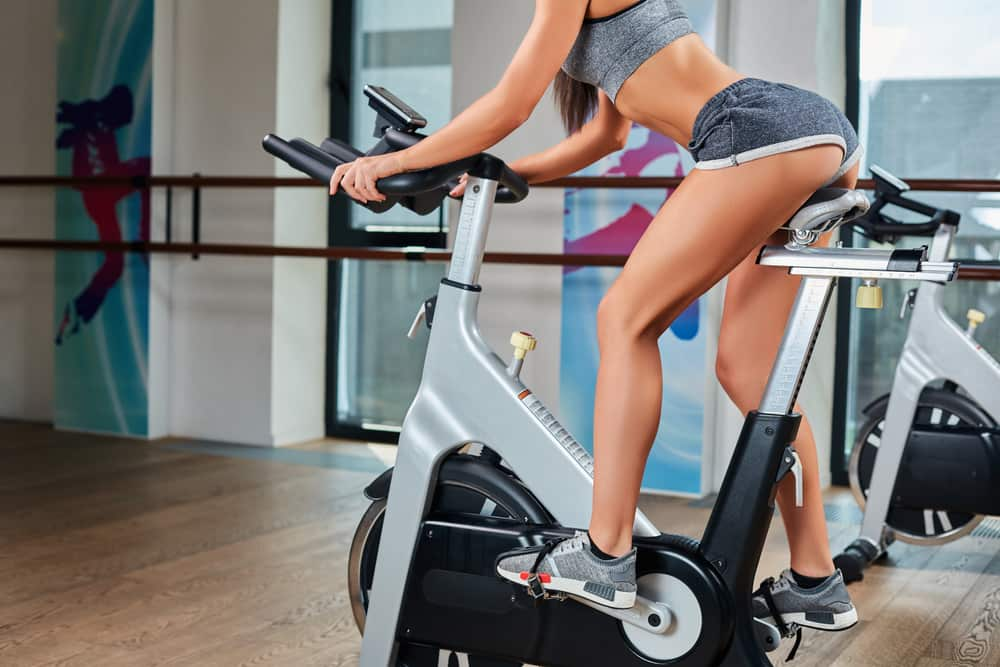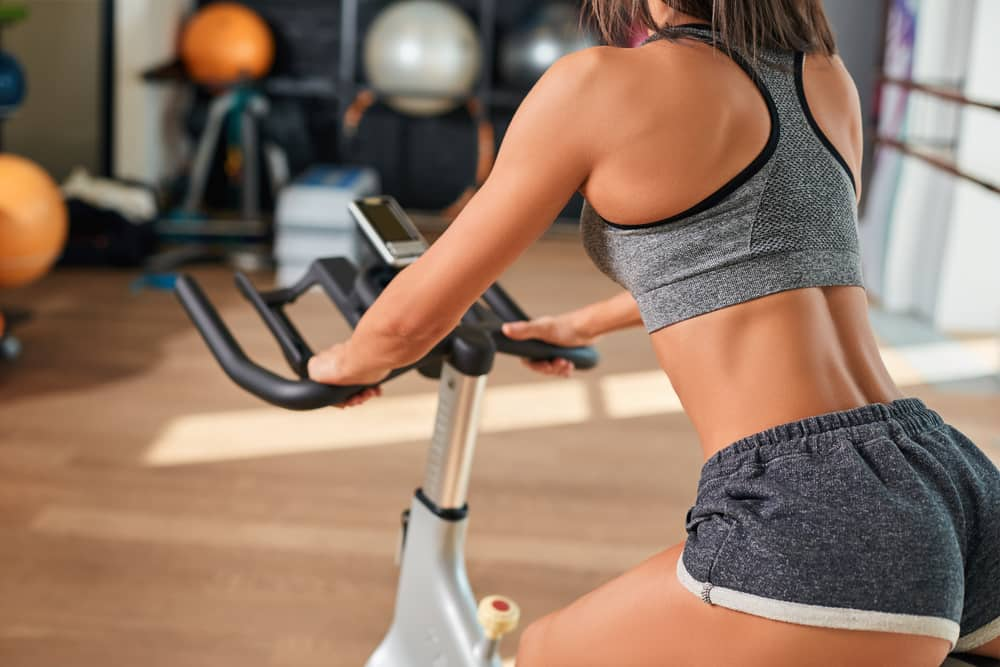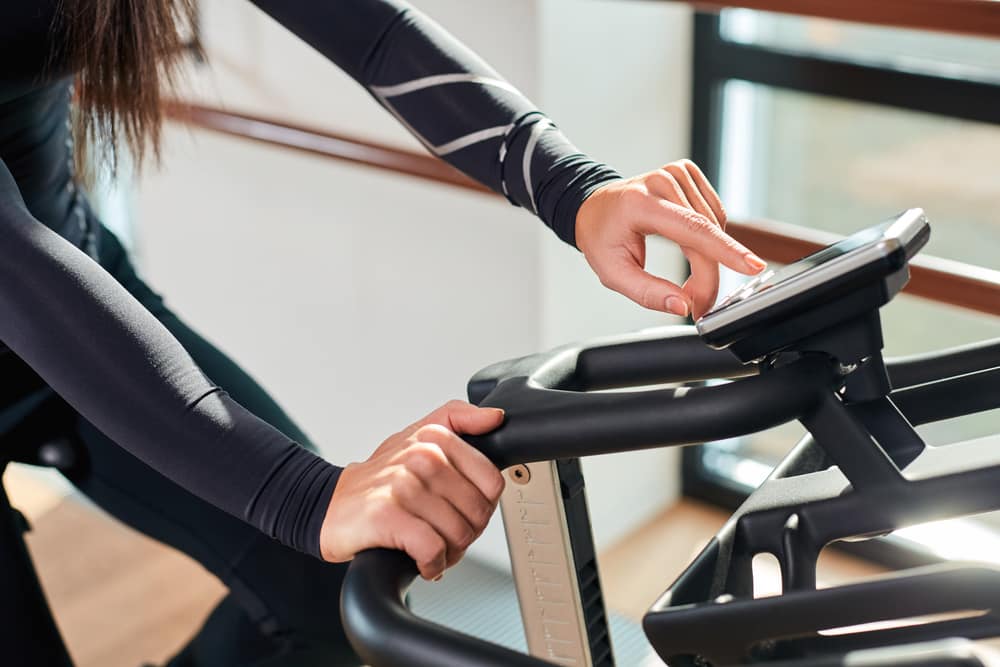Indoor cycling is perfect for high caloric burn and weight loss. But you can also use the stationary bike to work on your muscles.
This exercise equipment can tone your upper body muscles and lower legs, hips, core and upper body. It also targets the most important muscle of all – our heart!
Let’s learn more about these muscle groups and find out how you can optimise your workout routine for muscle building.
What Muscles Does a Stationary Bike Tone?
Your legs are not the only muscles you get to work on a stationary bike.
Biking, when done right, can provide a full-body workout, targeting even your midsection and upper body.
Here are the specific muscles involved in an indoor cycling workout.
Upper Leg Muscles
You exercise two upper leg muscle groups as you pedal on your stationary bike.
One is your quadriceps or the four muscles of your front thigh. The other is the hamstrings or the muscles of your back thigh.
You work your quads as you pedal downwards, while you target your hamstrings as you bring the pedal upwards.
Cycling tips
- Try riding with clip-in cycling shoes. Some exercise bikes, like the NordicTrack Commercial S22i, have SPD cleats for extra pedalling power. With this feature, you’ll work on your hamstrings more as you use your legs to pull the pedals up.
- Start with a comfortable resistance level. Too much resistance on your stationary bike will not work your muscles harder. It will only put your knees at risk. Stick to a resistance option that matches your fitness level, then shift to a higher gear as you strengthen your leg muscles more.
Lower Leg Muscles
The stationary bike also works on the muscles at the back of your lower leg. These are your calves, also triceps sural.
The role of this muscle group is to let you push and pull your leg while pedalling.
Specifically, you use your primary calf muscles or gastrocnemius to perform this movement pattern.
Cycling tip
- Flex your feet throughout your cycling routine. It ensures that your calves get the best workout. Any pair of cycling shoes should help you execute this motion properly.

Gluteal Muscles
Another large muscle that stationary bikes work on is your glutes or buttocks.
This muscle group activates as you push your legs down while pedalling.
When cycling, your glutes work with your hip flexors or the muscle group supporting the ball-and-socket joint of your legs.
As you pedal with your leg and knee moving up towards your chest, you tone and stretch both glutes and hip flexors.
You also get the same muscle toning effect when you run or walk.
Cycling tip
- Use a spin bike to target your glutes more. Spin bikes allow you to lean forward, making your glutes work harder. Upright and recumbent bikes require you to sit up most of the time, so gluteal muscle impact is less.
Core Muscles
A stationary bike may not work your abdominal muscles enough to get a six-pack.
But this exercise machine can surely strengthen them.
You draw your belly button towards your spine as you hold the handlebars while pedalling.
Doing this engages your core and keeps you stable on the bike.
In turn, you get strong abs that can support your body from the hips down.
Cycling tip
- Use an upright or recumbent bike for a good core workout. Your abs get to work more when you are in a seated or reclined position. You also want to maintain proper form and posture for optimum results.
Arm Muscles
Holding the handlebars lets you work on your arm muscles. Specifically, you get to target the biceps and triceps.
Like the core, you do not get as much arm activity from cycling.
However, arm muscle activation increases as you tighten your grip on the handlebars.
Cycling tips
- Work your arms more by increasing the bike resistance. Doing so will push you to sprint or ride out of the saddle. As a result, you tighten your hold on the handle and exercise your arms.
- Find a stationary bike with light weights included. Some bike models come with a pair of dumbbells that you can use for a good arm workout. Try incorporating these beginner dumbbell exercises into your biking routine.

Lower Back Muscles
You exercise your lower back muscles on the stationary bike as you hold the handlebars and tilt your upper body forward.
Specifically, your quadratus lumborum muscle supports your spine and keeps you in a stable position as you pedal.
The back muscles work in tandem with your core during cycling.
And as you strengthen both through this exercise, you’ll notice that your ride will become steadier and more comfortable.
Cycling tip
- Maintain a good posture. Slouching will only cause back aches from cycling and lessen core engagement. So, watch your cycling form and positioning to avoid workout pains or injury and get maximum benefits.
Heart Muscles
A stationary exercise bike does not only work the muscles you can see. It also targets your heart and offers a good cardio workout. Remember, this organ composes of several muscles.
And as you exercise on the bike, your heart rate speeds up, too.
Making cycling a routine can then strengthen your heart muscles, burn calories and speed up fat loss.
All these improve your overall health status and protect you from cardiovascular diseases.
Cycling tip
- Boost your heart rate through HIIT. High-intensity interval training lets you briefly pedal at high speeds, followed by active recovery. This alternating pattern encourages you to take up more oxygen and increase caloric burn within a short time. And with effective weight loss, you gain more muscles and a better physique.
How Do I Build Muscles on a Stationary Bicycle?
Toning muscles using a stationary bike is more than getting a better-looking body. It is also an excellent way to burn calories and continue doing so even at rest.
That is why you need to know how to use your exercise bike for muscle building. Here’s a list of tips to help you out:
- Boost your resistance. Experts agree that a good resistance setting is when you cannot pedal faster than 60 rpm. You can also set it to a level where you cannot maintain the intensity for more than 1 to 2 minutes.
- Perform sprints and interval training. Once you get past the beginner stage, you can try sprinting, where you pedal as hard as you can for a short time. You can start with 30-second sprints followed by a 50-second recovery time, then repeat. As you build more stamina, try extending your sprint time or shortening your recovery period.
- Try different riding positions. Hovers are probably the most popular biking technique. It’s an excellent isolation exercise to target your quads. You can also incorporate this into your interval training if you like.

How Long Does It Take for Cycling to Build Muscles?
Getting a more athletic build takes time. You need to bike consistently to lose weight and, eventually, tone your muscles.
And after 4 to 6 weeks of constant cycling, you’ll notice firmer legs, thighs and buttocks.
Your stationary bike workouts will start to feel less demanding, too.
It’s your sign that you can now take your cycling session to the next level. That way, you continue losing weight and building muscle mass.
Biking results will be more evident in the second or third month. By this time, your body will be more defined and muscular.
You can also use a digital smart scale with helpful weight loss metrics, if you like, to track your progress more objectively.
Conclusion
A stationary bike can work on your muscles for sure.
But a consistent routine, paired with a healthy diet, is essential for optimum results.
Proper biking form, position, resistance level and speed are crucial, too.
And if you want to target a specific muscle group, you would have to choose the right type of exercise bike.
Make sure to read product features, reviews and buying guides.
That way, you’ll know you’re using the right cardio equipment for your fitness goals.
Related Questions
1. Does a stationary bike make your legs and thighs bigger?
Cycling can tone your leg muscles and thighs, giving them a more defined shape. However, this exercise is not enough to make your legs bulky. For that to happen, you would have to do weightlifting to train your legs and adjust your diet.
2. Do outdoor and indoor bikes target the same muscle groups?
Both outdoor and indoor bikes target the same muscles. However, the bike type you use can affect the load muscle groups get from the workout. For instance, outdoor bikes target your core and upper body more as they work harder to keep you steady on uneven road conditions. Indoor cycling that involves extra arm movements or hands-free riding also has different muscular effects.
- What Are the Advantages and Disadvantages of Folding Treadmills? - 11 March 2025
- Can You Use a Massage Gun When Pregnant? - 10 March 2025
- What is the Best Pre-Run Food? - 6 March 2025
